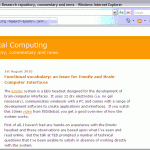The problem with collecting in any amount of data is figuring out how to present that data in a manner that is meaningful for its intended audience. For example if you want to assess the physical effort you exert during a run a plot of physiological activity (e.g. heartbeat rate) against time will provide you with a relatively simple visual representation of how your body adapts to physical stress.
The Moody Web
We’re sporting a new look this month here at Physiological Computing, several in fact, as we’ve turned the web interface into an online mood ring. Using the online heartbeat rate of our body blogger (read more here on the BodyBlogger) the colour scheme of the site is set according to the users current physiological state.
Currently 4 colour schemes are supported: –
Each scheme is mapped onto a different physiological range which are as follows: –
- Relaxed: less than 60 beats per minute (bpm)
- Normal: 60 to 80 bpm
- Elevated: 80 to 100 bpm
- Burning: More than 100 bpm
These ranges and their implied state have been configured for our current body blogger who transitions through them on a daily basis (e.g. burning – running).
I’ll be updating more about the Moody Web later on this week, for the time being enjoy our take on adding a touch of the personal to the web.
Functional vocabulary: an issue for Emotiv and Brain-Computer Interfaces
The Emotiv system is a EEG headset designed for the development of brain-computer interfaces. It uses 12 dry electrodes (i.e. no gel necessary), communicates wirelessly with a PC and comes with a range of development software to create applications and interfaces. If you watch this 10min video from TEDGlobal, you get a good overview of how the system works.
First of all, I haven’t had any hands-on experience with the Emotiv headset and these observations are based upon what I’ve seen and read online. But the talk at TED prompted a number of technical questions that I’ve been unable to satisfy in absence of working directly with the system.
Continue reading
Calm your spirits Kusagari, Red Steel 3 unlikely to use the Wii Vitality
In April there was a rumour going around that the next Red Steel (the third in the series) might support the Wii Vitality. The gameplay in Red Steel is a mixture of first person shooting and first person sword fighting. In the last Red Steel the combat system felt very similar to that of two-player fighting games like Street Fighter as apart from the basic sword fighting techniques you can perform with the Wii controller (e.g. blocking and striking) you could also pull off a range of special moves with different combinations of gestures and key presses. I’m a big fan of the Red Steel franchise and I believe it would be an interesting series to explore biofeedback based gameplay mechanics as both the mythos and the physical skillset being simulated in Red Steel lends itself well to intrinsically interesting physiological manipulations (e.g. as your playing a swordsman, “zen” powers aren’t too much of stretch for your suspension of disbelief). Below I’ve made a couple of suggestions as to what biofeedback based gameplay mechanics you might find in the next Red Steel game if it uses the Wii Vitality: –
Better living through affective computing
I recently read a paper by Rosalind Picard entitled “emotion research for the people, by the people.” In this article, Prof. Picard has some fun contrasting engineering and psychological perspectives on the measurement of emotion. Perhaps I’m being defensive but she seemed to have more fun poking fun at the psychologists than the engineers, but the central impasse that she identified goes something like this: engineers develop sensor apparatus that can deliver a whole range of objective data whilst psychologists have decades of experience with theoretical concepts related to emotion, so why haven’t people really benefited from their union through the field of affective computing. Prof. Picard correctly identifies a reluctance on the part of the psychologists to define concepts with sufficient precision to aid the work of the engineers. What I felt was glossed over in the paper was the other side of the problem, namely the willingness of engineers to attach emotional labels to almost any piece of psychophysiological data, usually in the context of badly-designed experiments (apologies to any engineers reading this, but I wanted to add a little balance to the debate).
Continue reading
The Body Blogger
A new page has been added to the navigation bar. “The Body Blogger” concerns our work in live blogging a user’s physiological state to the web and what impact it may have on the user as well as their audience. The body blog can be found at http://twitter.com/bodyblogger.
Post E3: Without Vitality we draw upon Innergy
Well that was a disappointment. In the end Nintendo decided against demonstrating the Wii Vitality at this year’s E3. A representative of the company stated that the Vitality was a no-show because Nintendo did not believe the event was a suitable environment for the product. Disappointing but given their press event was jam packed with a number of AAA games and a new portable it was understandable. However with the Vitality aimed for a late 2010 release it doesn’t give Nintendo much time to create a buzz around a product that frankly has none. In actuality I was surprised that Nintendo didn’t use their recent endorsement deal with the American Heart Association to hype Vitality pre E3. While the product is currently being marketed towards mental health (i.e. stress management), rather than physical health which the AHA endorsement concerns, Nintendo could of easily used the event as part of a broader health platform and so make better use of the publicity the endorsement deal attracted.
Continue reading
iBrain
I just watched a TEDMED talk about the iBrain device via this link on the excellent Medgadget resource. The iBrain is a single-channel EEG recording collected via ‘dry’ electrodes where the data is stored in a conventional handheld device such as a cellphone. In my opinion, the clever part of this technology is the application of mathematics to wring detailed information out of a limited data set – it’s a very efficient strategy.
The hardware looks to be fairly standard – a wireless EEG link to a mobile device. But its simplicity provides an indication of where this kind of physiological computing application could be going in the future – mobile monitoring for early detection of medical problems piggy-backing onto conventional technology. If physiological computing applications become widespread, this kind of proactive medical monitoring could become standard. And the main barrier to that is non-intrusive, non-medicalised sensor development.
In the meantime, Neurovigil, the company behind the product, recently announced a partnership with Swiss pharmaceutical giants Roche who want to apply this technology to clinical drug trials. I guess the methodology focuses the drug companies to consider covert changes in physiology as a sensitive marker of drug efficacy or side-effects.
I like the simplicity of the iBrain (1 channel of EEG) but speaker make some big claims for their analysis, the implicit ones deal with the potential of EEG to identify neuropathologies. That may be possible but I’m sceptical about whether 1 channel is sufficient. The company have obviously applied their pared-down analysis to sleep stages with some success but I was left wondering what added value the device provided compared to less-intrusive movement sensors used to analyse sleep behaviour, e.g. the Actiwatch
Pre-E3: Thoughts on the Wii Vitality
With only hours left until Nintendo’s E3 press event I’ve once again been pondering what we’ll see from the Wii Vitality. At last year’s E3 the device’s announcement didn’t exactly wow the audience. It’s not surprising as Nintendo didn’t provide a demonstration of the device which might have bought gamers into the concept. Nintendo have remained tight lipped ever since revealing absolutely nothing about what we might expect from the device. Over the past year it has been suggested the Vitality will be used to monitor the scare factor in games, alter game difficulty, be used as an input for relaxation and exercise games as well as in lie-detection of which I discussed one particular method of implementation here.
Implementing these types of games are indeed possible using physiological measures and you can see versions of these games in the biofeedback and academic game communities for example: –
- The Journey to Wild Divine: series of relaxation mini-games controlled using heartbeat rate and skin conductance.
- A Fitness Game Reflecting Heart Rate: boxing game which adapts the gameplay in order to move you towards a target heartbeat rate. Enemy characters require a different physical movement to destroy them, depending on the player’s current heartbeat rate and the goal an appropriate enemy will be selected.
- Fairies: target acquisition game which alters the player’s perception of the games difficulty according to the player’s level of arousal as denoted by heartbeat rate.
There are many ways you can use physiological data in gameplay, it’s all a question of how you make the input meaningful for the player (e.g. if the player’s relaxation level is used to switch between character states, those states have to be somewhat representative of the change, so if the player is controlling an avatar with a pyrotechnic ability then a shift from a relaxed state to an agitated state could be used to trigger their fire ability and vice versa, this would be a meaningful relationship).
The problem I have with the Vitality is in their choice of sensor: a finger based pulse oximeter. A pulse oximeter uses infra-red to track the changes in the volume of blood in the extremities and from this derive heartbeat rate. If you want to support a wide selection of different play styles (e.g. relaxation, exercise, affective) a finger based sensor would not have been my first choice considering the following issues: –
- A finger based sensor limits the player’s freedom of movement. Any physical activity will move the sensor from its recording position and may even possibly become disconnected, both events of which will create data errors. And depending on how responsive the game is to the player’s physiology it can easily lead to erroneous game behaviour. This will limit how the data can be used in a given context (e.g. a game responsive to emotional physiological responses is not suited to a game involving gestures, this example is more prelevant for the Wii as the system sells itself on physical interaction as the standard input method). Also the physicality of the sensor attachment to the player’s finger restricts player movement so physical actions may become uncomfortable (e.g. imagine playing Red Steel with a cable attached to your finger). This is not to say games involving physical actions will be taboo using the Vitality (e.g. a calorie counter in an exercise game), it just makes it harder.
- With a finger based sensor use of the second Nunchuk is liable to become awkward possibly eliminating it as an input device.
Ideally Nintendo should have gone with either an earlobe based pulse oximeter thereby freeing up the hands (though physical actions still have to be limited as that sensor is not the most secure under intense movement) or ideally a chest-strap*. A chest-strap sensor provides the most secure method of measuring a player’s heartbeat rate as the centre of the body is pretty stable under movement, this is especially true from my perspective given I’ve been wearing one for the last several months collecting data.
At this point these issues are pretty much moot (more like irritations in my noggin I can’t dispell) as I suspect Nintendo will launch the system with a series of relaxation games which the Vitality is clearly geared for**. Or perhaps a lie-detection game as I’ve talked about before.
* The problem inherent in using a chest-strap is in how the player may perceive it invading their personal space. The chest-strap is an up-and-close personal wearable device, and I imagine given the new wireless heart monitor EA Sports Active 2.0 is using (an armband based heart monitor), there development staff thought so too. The finger attachment does not invade the player’s space so there is no unease in wearing the device. Having just seen EA’s E3 press conference, the Vitality is already looking obsolete.
**The sensor used by The Journey to Wild Divine has been used in a multitude of different game genres, my favourite being the Half-Life 2 mod Please Don’t Feed the BioZombies. However the sensor is used in conjunction with a mouse and keyboard and this setup doesn’t suffer from player movement to the same degree the Vitality will given the nature of the input device doesn’t require much. Also unlike Vitality a mouse and keyboard is placed on a flat providing support for the hand the sensor is on.
In the shadow of the polygraph
I was reading this short article in The Guardian today about the failure of polygraph technologies (including fMRI versions and voice analysis) to deliver data that was sufficiently robust to be admissible in court as evidence. Several points made in the article prompted a thought that the development of physiological computing technologies, to some extent, live in the shadow of the polygraph.
Think about it. Both the polygraph and physiological computing aim to transform personal and private experience into quantifiable data that may be observed and assessed. Both capture unconscious physiological changes that may signify hidden psychological motives and agendas, subconscious or otherwise – and of course, both involve the attachment of sensor apparatus. The convergence between both technologies dictates that both are notoriously difficult to validate (hence the problems of polygraph evidence in court) – and that seems true whether we’re talking about the use of the P300 for “brain fingerprinting” or the use of ECG and respiration to capture a specific category of emotion.
Whenever I do a presentation about physiological computing, I can almost sense antipathy to the concept from some members of audience because the first thing people think about is the polygraph and the second group of thoughts that logically follow are concerns about privacy, misuse and spying. To counter these fears, I do point out that physiological computing, whether it’s a game or a means of adapting a software agent or a brain-computer interface, has been developed for very different purposes; this technology is intended for personal use, it’s about control for the individual in the broadest sense, e.g. to control a cursor, to promote reflection and self-regulation, to make software reactive, personalised and smarter, to ensure that the data protection rights of the individual are preserved – especially if they wish to share their data with others.
But everyone knows that any signal that can be measured can be hacked, so even capturing these kinds of physiological data per se opens the door for spying and other profound invasions of privacy.
Which takes us inevitably back in the shadow of the polygraph.
I’m sure attitudes will change if the right piece of technology comes along that demonstrates the up side of physiological computing. But if early systems don’t take data privacy seriously, as in very seriously, the public could go cold on this concept before the systems have had a chance to prove themselves in the marketplace.
For musings on a similar theme, see my previous post Designing for the Guillable.




